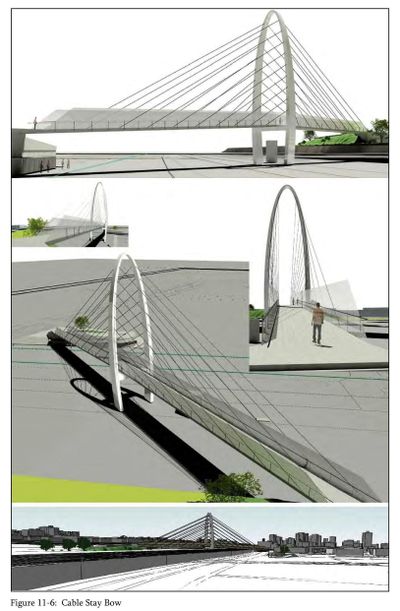University District pedestrian bridge would link campus to South Side

The city of Spokane held an open house about the University District Bridge on Thursday presenting the $12 million to $13 million pedestrian bridge that would span Martin Luther King Jr. Way and the Burlington Northern and Santa Fe tracks just south of the Riverpoint Campus.
The pedestrian bridge would connect the location of Washington State University’s rapidly expanding College of Medical Sciences north of the tracks with the neighborhood south of the tracks.
The cable-stayed bridge would be 120 feet tall at the top of its arch – just a bit shorter than the Clocktower in Riverfront Park.
A $3.1 million state grant covered the $1.3 million design contract, as well as the cost of some of the property needed to expand the city’s right of way near the intersection of Riverside Avenue and Sherman Street where the bridge touches down on the south side of the tracks.
The need for a pedestrian bridge connecting the University District to the neighborhood south of the tracks was first indentified about 10 years ago. During presentations and open houses over the last four years, the project has received almost 700 public comments.
Terren Roloff, director of communications and public affairs at WSU Spokane, said the bridge would be a welcome connector for health science students taking classes at Riverpoint, but living and interning near the hospitals.
“There is no real easy way to get to campus,” Roloff said, “we are locked in between Division, Hamilton, the river and the train tracks.”

WSU is not funding the project but will provide in-kind donations of land and future maintenance of the bridge and its surroundings, Roloff said, as well as security monitoring.
City spokeswoman Julie Happy said public input may still be submitted at www.university districtbridge.com, but added that the design of the bridge is very close to completion.
The estimated cost of the bridge is $7.6 million, with the total cost of the project expected to come in around $13 million. Happy said that the city is seeking construction funding through grants as they become available.
“We will not have a construction date scheduled until we have construction funding in place,” Happy said. “We are hopeful to obtain grant funds in time for a late 2016 construction timeframe.”